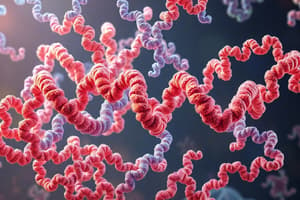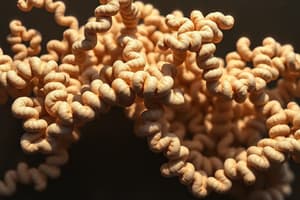Podcast
Questions and Answers
What primarily remains unaffected during the denaturation of proteins?
What primarily remains unaffected during the denaturation of proteins?
- Quaternary structure
- Tertiary structure
- Secondary structure
- Primary structure (correct)
Which of the following agents is least likely to cause protein denaturation?
Which of the following agents is least likely to cause protein denaturation?
- Organic solvents
- High pressure
- 70% alcohol solution
- Mild soap (correct)
What is a common result of protein denaturation?
What is a common result of protein denaturation?
- Loss of biological activity (correct)
- Stabilization of protein structure
- Formation of disulfide bonds
- Increased enzymatic activity
Which physical agent is explicitly mentioned as causing denaturation?
Which physical agent is explicitly mentioned as causing denaturation?
Which of the following is a biological consequence of protein denaturation?
Which of the following is a biological consequence of protein denaturation?
What is the primary role of chaperones in protein folding?
What is the primary role of chaperones in protein folding?
Which of the following is NOT a consequence of protein misfolding?
Which of the following is NOT a consequence of protein misfolding?
What triggers the formation of amyloidosis?
What triggers the formation of amyloidosis?
Which family of proteins is known as molecular chaperones?
Which family of proteins is known as molecular chaperones?
How do hydrophobic interactions contribute to protein stability?
How do hydrophobic interactions contribute to protein stability?
What is the function of the Hsp 70 family of proteins?
What is the function of the Hsp 70 family of proteins?
What is a characteristic feature of the proteins implicated in Alzheimer's disease?
What is a characteristic feature of the proteins implicated in Alzheimer's disease?
Which process is critical for reducing the unstable interactions of misfolded proteins?
Which process is critical for reducing the unstable interactions of misfolded proteins?
Which of the following best describes the primary structure of a protein during denaturation?
Which of the following best describes the primary structure of a protein during denaturation?
Which physical agent is capable of causing protein denaturation?
Which physical agent is capable of causing protein denaturation?
What is a chemical result of exposure to acid gastric juices on proteins?
What is a chemical result of exposure to acid gastric juices on proteins?
What effect does a 70% alcohol solution have on bacterial cells?
What effect does a 70% alcohol solution have on bacterial cells?
What is a consequence of protein aggregation during misfolding?
What is a consequence of protein aggregation during misfolding?
What primarily aids in maintaining the structural stability of proteins during folding?
What primarily aids in maintaining the structural stability of proteins during folding?
What role do chaperonins, such as GroEL/Hsp 60, play in protein folding?
What role do chaperonins, such as GroEL/Hsp 60, play in protein folding?
What can result from gene mutations affecting proteins?
What can result from gene mutations affecting proteins?
Which of the following diseases is associated with the accumulation of misfolded protein aggregates?
Which of the following diseases is associated with the accumulation of misfolded protein aggregates?
What type of protein aggregates are commonly seen in Alzheimer's disease?
What type of protein aggregates are commonly seen in Alzheimer's disease?
How do proteins manage to avoid aggregation during the folding process?
How do proteins manage to avoid aggregation during the folding process?
What is a consequence of proteolytic cleavage of certain proteins?
What is a consequence of proteolytic cleavage of certain proteins?
What is the primary function of Hsp 70 family of proteins?
What is the primary function of Hsp 70 family of proteins?
Flashcards
Protein Denaturation
Protein Denaturation
The disruption of a protein's shape (secondary, tertiary, and quaternary structures), caused by the breaking of weak bonds, like hydrogen bonds. The primary structure, the sequence of amino acids, remains unaffected.
Agents of Denaturation
Agents of Denaturation
Heat, high pressure, UV light, violent shaking, and strong acids are all examples of agents that disrupt protein structure.
Loss of Protein Activity
Loss of Protein Activity
Denaturation often leads to loss of protein function, such as the ability to bind to other molecules or catalyze reactions.
Applications of Denaturation
Applications of Denaturation
Signup and view all the flashcards
Harmful Effects of Denaturation
Harmful Effects of Denaturation
Signup and view all the flashcards
Protein Folding
Protein Folding
Signup and view all the flashcards
Hydrophobic Interactions
Hydrophobic Interactions
Signup and view all the flashcards
Chaperones
Chaperones
Signup and view all the flashcards
Hsp70
Hsp70
Signup and view all the flashcards
GroEL/Hsp60
GroEL/Hsp60
Signup and view all the flashcards
Protein Aggregation
Protein Aggregation
Signup and view all the flashcards
Amyloidosis
Amyloidosis
Signup and view all the flashcards
Alzheimer's Disease
Alzheimer's Disease
Signup and view all the flashcards
Denaturing Agents
Denaturing Agents
Signup and view all the flashcards
Examples of Denaturing Agents
Examples of Denaturing Agents
Signup and view all the flashcards
Protein Degradation
Protein Degradation
Signup and view all the flashcards
Study Notes
Biochemistry: Protein Folding
- Protein folding is a physical and dynamic process.
- Polypeptides fold into a 3-dimensional conformation for proper function.
- Spontaneous folding is aided by hydrophobic interactions, burying hydrophobic amino acids within the protein structure.
- Hydrophobic interactions keep proteins stable and biologically active, reducing surface area.
- Chaperones (heat shock proteins) assist in correct folding and prevent aggregation.
- Chaperones help proteins fold into functional structures.
- Chaperones, specifically Hsp 70 and GroEL/Hsp 60, are crucial for proper protein folding.
- Hsp stands for heat shock protein
Protein Misfolding
- Protein misfolding can result from spontaneous processes or gene mutations.
- Abnormal proteolytic cleavage can lead to misfolding.
- Partially or improperly folded proteins may interact with chaperones.
- Misfolded proteins form insoluble aggregates.
- Accumulation of misfolded protein aggregates leads to diseases like Alzheimer's, Parkinson's, and Type II diabetes.
- Diseases associated with misfolded proteins include Alzheimer's disease (amyloid beta and tau), Parkinson's disease (alpha-synuclein), and Type II diabetes (amylin).
Protein Denaturation
- Denaturation disrupts secondary, tertiary, and quaternary protein structure.
- Primary structure and peptide bonds remain unchanged.
- Physical agents like heat, UV light, ultrasound, high pressure, and violent shaking denature proteins.
- Chemical agents like strong acids, strong alkalies, organic solvents, and heavy metal salts also denature proteins.
- Denaturation has applications in sterilization and disinfection.
- Denaturation leads to loss of protein activity, antigen-antibody reaction, and easier digestion.
- Medical supplies and instruments are sterilized using heat to denature proteins.
- Acidic gastric juices denature proteins to break down food.
- Alcohol (70%) is used as a disinfectant, penetrating bacterial cell walls and denaturing proteins and enzymes.
- Denaturation affects a protein's ability to perform its function.
- Denaturation results in unfolding of the protein molecule and the destruction of some subsidiary hydrogen bonds.
- Exposure of some groups like SH (cysteine) is possible during denaturation.
Studying That Suits You
Use AI to generate personalized quizzes and flashcards to suit your learning preferences.




